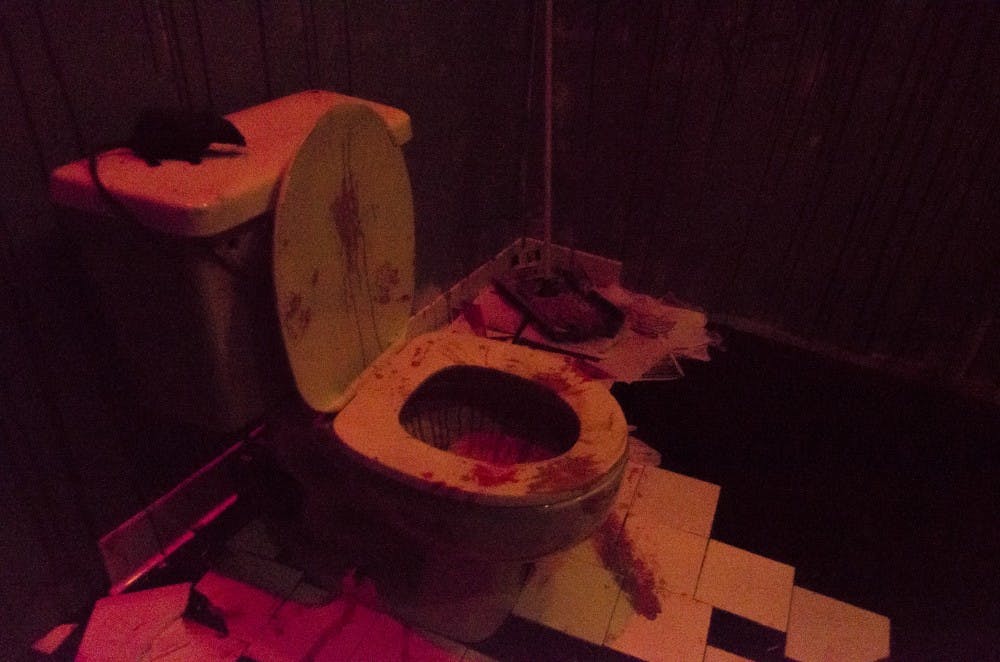By ANEEKA RATNAYAKE For The News-Letter
With “Fever Dream” as this year’s theme, students from The Maryland Institute College of Art (MICA) staged their annual haunted house starting last weekend.
Described to the public as “detailed, immersive and horrifying,” this student-run production required the effort of 25 students, including five leaders who work year-round to organize the show. Construction of the intricate sets began about a week before the official opening.
The students also take part in the installation as actors in the haunted house’s different scenes. One of the leaders, Cassie Tucker, a senior illustration major at MICA, spoke with The News-Letter about the students’ overall artistic vision.
“We really wanted to make the audience feel like they’re in a bad dream,” Tucker said.
Tucker explained that the students take their goals for the haunted house seriously, and they aim to be as frightening as possible.
She added that although the MICA Haunted House has been running for about eight years now, the past few years have demonstrated the students’ increased dedication to the element of fear.
In order to stage their production, the students divide a campus multipurpose auditorium room into several sections, allowing for the creation of diverse scenes.
Although the space itself is not very large, the students create a maze for the audience to circulate through in twisted patterns, creating a longer, more engaging experience.
From the set design to the detailed makeup and costumes, every element of the haunted house was intricately crafted, immersing the audience in the students’ warped concept of a “fever dream.”
In addition to the frightening visual effects, audience members had the option to be touched by the actors. Audience members gave permission by signing a waiver and wearing designated glow bracelets. As they made their way through the haunted house, this option enhanced the intensity of their experience.
At the entrance, the haunted house opened with the premise that the audience was about to embark on an experiment that tested elements of the human sleep cycle. A student dressed as a hospital nurse eerily informed visitors of their role as test subjects and then motioned them through a white curtain.
After drinking an unnamed “sedative” — in this case, small cups of water — visitors were immediately launched into the haunted house and a series of dreamscapes.
The first of the many dreamscapes opened with an unnatural-looking, four-legged creature greeting visitors. The strange monster not only shocked anxious audience members at the entrance but also demonstrated MICA students’ creativity in conceptualizing their own monsters.
What was truly engaging, however, was the manner in which the actors interacted with the audience members in their journey through the haunted house. In many scenes the actors would take a viewer’s hand and guide them to an increasingly frightening element of that scene, forcing them to the forefront of their nightmares.
For example, in a muted party scene, grave-looking actors hovered over viewers and ushered them towards a wall punctured with peepholes. Looking through these tiny apertures, viewers saw another scene in which an unfortunate girl was having her mouth stitched shut.
Also during this party scene, one audience member was pulled away and had a mask placed on her face.
In other scenes, actors worked to inhibit viewer’s passage through the haunted house. For instance a girl emerged suddenly from one scene, grabbing an unsuspecting patron’s foot in order to stop anyone from leaving the area. In addition demonic clowns forced audience members to duck underneath a rainbow parachute in order move forward. These interactions were both unpredictable and unexpected, thereby adding to the overall tension and fear created.
Other notable scenes within the haunted house included a tooth extraction, a cemetery, a bloody bathroom and an area in which zombie-like characters ironed and did other household chores.
“This year we’re trying to incorporate all senses,” Tucker said.
This goal was certainly achieved through the actor-audience interaction. MICA created a truly frightening overall experience with their “Fever Dream” haunted house this year.





